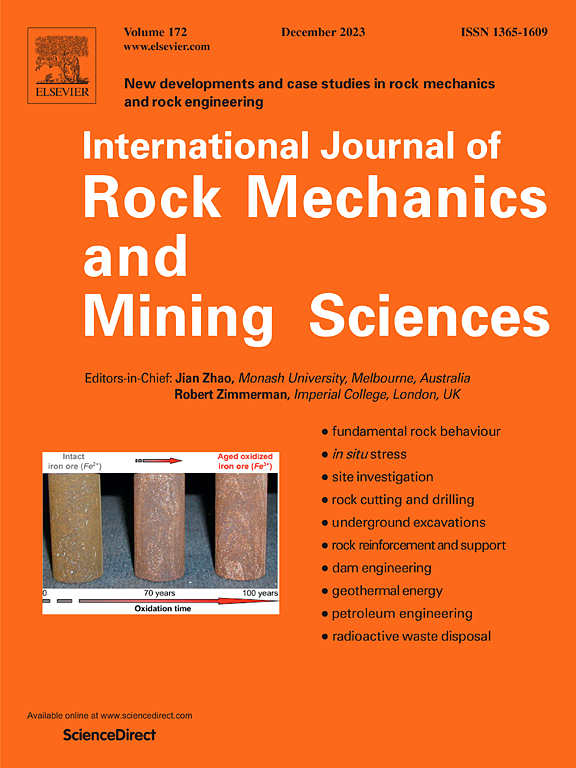A nonlinear flow model and criterion for 3D natural fracture intersections: Effects of surface roughness and mechanical aperture
IF 7.5
1区 工程技术
Q1 ENGINEERING, GEOLOGICAL
International Journal of Rock Mechanics and Mining Sciences
Pub Date : 2025-06-02
DOI:10.1016/j.ijrmms.2025.106169
引用次数: 0
Abstract
Characterization of hydraulic behavior of intersected fractures is of great importance for evaluating flow properties within fractured rock masses. Nevertheless, existing flow models that correlate fracture geometries with nonlinear flow behaviors remain limited in predictive accuracy. To develop a nonlinear flow model and criterion based on fracture geometries that accurately represent real-world conditions, a series of three-dimensional (3D) intersected fracture models were created using surface morphology extracted from split granite blocks. Then, water flow-through simulations were performed on the generated fracture intersections subjected to varying hydraulic gradient conditions. The results demonstrate complex streamline patterns and significant nonlinear flow processes at fracture intersections with complex geometries. With increased roughness coefficient (JRC), decreased mechanical aperture (em) and reduced aperture ratio (e’), the nonlinearity of flow increases, and the intrinsicpermeability (k) decreases. The critical hydraulic gradient (Jc) associated with the onset of nonlinear flow decreases with increasing JRC, em, and e’. Furthermore, a notable coupling effect of surface roughness and mechanical aperture on the nonlinear flow behaviors of fracture intersections has been revealed. Based on the established relationships between hydraulic properties (Jc and inertial permeability ki) and geometric parameters (JRC and em), a nonlinear flow model and a criterion were proposed to quantitatively determine the fracture permeability under nonlinear flow regimes. This study provides insights into the nonlinear flow behaviors within 3D natural fracture intersections, allowing quantitative identifications of flow regimes and evaluations on the nonlinear permeability. These findings contribute to a more accurate characterization of the hydraulic properties in fractured rock masses.
三维自然裂缝相交的非线性流动模型及准则:表面粗糙度和机械孔径的影响
研究相交裂隙的水力特性对评价裂隙岩体内的流动特性具有重要意义。然而,现有的将裂缝几何形状与非线性流动行为相关联的流动模型在预测精度方面仍然有限。为了建立一个基于裂缝几何形状的非线性流动模型和准则,能够准确地反映真实情况,研究人员利用从花岗岩块体中提取的表面形态创建了一系列三维(3D)相交裂缝模型。然后,在不同水力梯度条件下,对生成的裂缝交叉点进行水流模拟。结果表明,在复杂几何形状的裂缝交叉处,复杂的流线模式和显著的非线性流动过程。随着粗糙度系数(JRC)的增大、机械孔径(em)的减小和孔径比(e’)的减小,流动非线性增大,本征渗透率(k)减小。随着JRC、em和e′的增大,与非线性流动开始相关的临界水力梯度(Jc)减小。此外,还揭示了表面粗糙度和机械孔径对断口交叉点非线性流动行为的显著耦合效应。基于已建立的水力特性(Jc和惯性渗透率ki)与几何参数(JRC和em)之间的关系,提出了非线性流动模式下定量确定裂缝渗透率的非线性流动模型和准则。该研究深入了解了三维天然裂缝交叉点内的非线性流动行为,从而可以定量识别流动状态并评估非线性渗透率。这些发现有助于更准确地描述裂隙岩体的水力特性。
本文章由计算机程序翻译,如有差异,请以英文原文为准。
求助全文
约1分钟内获得全文
求助全文
来源期刊
CiteScore
14.00
自引率
5.60%
发文量
196
审稿时长
18 weeks
期刊介绍:
The International Journal of Rock Mechanics and Mining Sciences focuses on original research, new developments, site measurements, and case studies within the fields of rock mechanics and rock engineering. Serving as an international platform, it showcases high-quality papers addressing rock mechanics and the application of its principles and techniques in mining and civil engineering projects situated on or within rock masses. These projects encompass a wide range, including slopes, open-pit mines, quarries, shafts, tunnels, caverns, underground mines, metro systems, dams, hydro-electric stations, geothermal energy, petroleum engineering, and radioactive waste disposal. The journal welcomes submissions on various topics, with particular interest in theoretical advancements, analytical and numerical methods, rock testing, site investigation, and case studies.

 求助内容:
求助内容: 应助结果提醒方式:
应助结果提醒方式:


